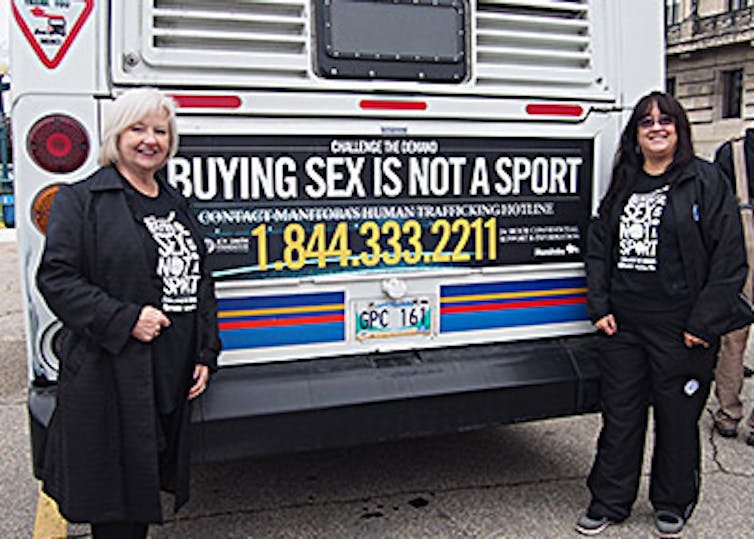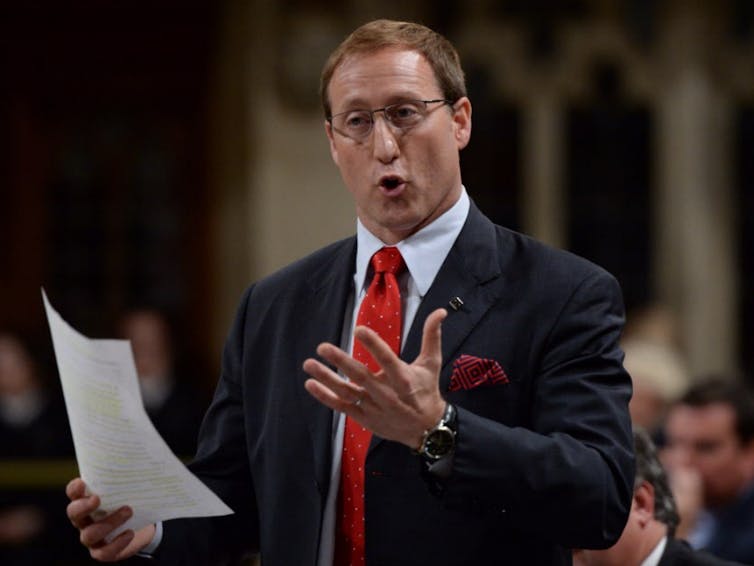Prostitution is now illegal in Canada. A criminal offence occurs every time sexual services are exchanged for compensation.
Canada’s new prostitution laws — which came into force in 2014 — are consistent with laws now in place in Sweden, Norway, Iceland, Northern Ireland, France and the Republic of Ireland. This approach — often referred to as the Nordic model — criminalizes the purchase of sexual services in an effort to end the practice of prostitution itself.
In Canada, four new criminal offences target prostitution and the development of economic interests in prostitution. Those who exchange their own sexual services for compensation cannot be prosecuted for their participation in the commission of the new offences.
Is prostitution itself harmful and exploitative? Or is sex work a legitimate form of labour that people should be permitted to safely engage in as a matter of personal choice?
This is the polarized debate playing out worldwide as countries struggle over how to legislate the commercial exchange of sex. The arguments are largely ideological, but they lead social discourse and influence what is researched, what problems are identified and what solutions are proposed.
One way of reconciling this divided debate is to identify who we are talking about when we talk about prostitution and sex work.
Prostitution is an activity. Those who support the Nordic model see that activity as harmful and seek to end its practice. Sex work is now frequently used to describe prostitution when engaged in by a subset of participants — adults, who consent, and who have not been coerced or trafficked. Advocates argue that sex work is a matter of individual choice and it can be made safer by decriminalizing all aspects of adult prostitution.
The debate over prostitution and sex work
In enacting the new prostitution laws, Parliament identified prostitution itself as a problem. Parliament expressed concerns about the exploitation inherent in prostitution and the risks of violence posed to those who engage in it. Those supporting the legislation expressed the belief that prostitution could not be made safe.
Parliament also expressed the view that prostitution causes social harms, including the objectification of the human body and commodification of sexual activity. To protect the human dignity and equality of all Canadians, they enacted laws focused on discouraging the activity of prostitution.
Some scholars agree with Parliament’s assessment of the problems associated with prostitution. They describe the activity of prostitution itself as a form of violence against women . They describe it as both a cause and consequence of gender inequality.
Researcher Meagan Tyler identifies three distinct types of harm to women who engage in prostitution: The increased likelihood of experiencing physical and sexual violence; the psychological harm, including post-traumatic stress and dissociation; and the harm associated with the sex of prostitution itself which, she argues, dehumanizes and objectifies women.

Definitions: Prostitution vs. sex work
Words are important in framing this debate.
The Supreme Court of Canada defined prostitution in the Prostitution Reference case as “the exchange of sexual services of one person in return for payment by another.” This definition has been consistently applied by all levels of courts in Canada.
Most advocates of the Nordic model or “end demand” approaches to prostitution focus on the activity of prostitution.
The term sex work was first used in a conscious effort to recast people selling sexual services as workers. In the 1970s, the sex workers’ rights movement began to reconstruct the problems associated with prostitution. Focus shifted from the activity itself to the individual rights of those who engaged in it. Prostitution was reframed as sex work and prostitutes as sex workers.
Like the general public, courts are increasingly using the term “sex work” in deference to the perceived preference of those who identify as sex workers and/or to recognize sex work as legitimate work. However, no Canadian court has to date defined the term and it’s often used interchangeably with prostitution.
Whose interests are included and whose are excluded when we use the term sex work? Whose rights are sex workers’ rights?
Over time, definitions of the term sex work have evolved. Sex work is now often used to refer to a subset of participants engaged in the activity defined as prostitution. The interests and experiences of some prostitution participants are, therefore, excluded from research and advocacy.

The fight for sex workers’ rights
In Canada, sex workers’ rights advocates recommend repealing all criminal laws that prohibit the purchase or sale of sexual services by adults and all criminal laws that limit adults from working with others in non-coercive situations. They argue that Canada’s existing adult prostitution laws are unconstitutional and violate the rights of sex workers.
The primary problems associated with sex work are identified as the role of stigma, criminal law and law enforcement in increasing the risks experienced by sex workers. Decriminalizing and destigmatizing sex work are important goals of the sex workers’ rights movement. Advocates suggest that decriminalization has the potential to make the activity of prostitution safer.
Some scholars agree that criminal laws and law enforcement strategies increase sex workers’ risk of experiencing harm while engaging in sex work. For example, research suggests that criminal laws preclude sex workers from taking steps that could reduce their risk of experiencing violence. Some such measures include screening clients ahead of time and working together with others.
In 2013, in finding three criminal prostitution laws unconstitutional, the Supreme Court of Canada agreed. They reasoned that the existing laws increased the risks of violence to prostitutes. They provided Parliament with 12 months to decide how to respond, and Parliament responded with the new legislation.
Sex workers aren’t trafficked
In recent advocacy promoting decriminalization of adult prostitution, three distinct characteristics distinguish sex workers from the broader group of people who engage in prostitution: They are not trafficked, they are consenting and they are adults.
A distinction is drawn between so-called forced prostitution (trafficking) and free prostitution (sex work). Advocates suggest that people have a right to choose sex work as an occupation, and that if they choose that occupation, they have the right to engage in it without violations of their human rights.
Amnesty International recently adopted a policy calling for the decriminalization of all aspects of adult consensual sex work. Amnesty defines sex work to include only consensual sex. Amnesty’s definition of sex work has been adopted by sex workers’ rights advocates in Canada.
Sex work is most often used to refer only to exchanges of sexual services between adults.
What about other prostitution participants?
If the word prostitution and the term sex work do not reflect the interests of the same individuals or groups, several things might concern us.
Should policy be generated on the basis of the rights of sex workers alone, or should the interests of everyone who engages in or is affected by prostitution be taken into account?
The proposal that all adult sex work be decriminalized is in fact a proposal that all adult prostitution be decriminalized. That is - that all criminal laws prohibiting the activity of prostitution when engaged in by adults be repealed.
This places full responsibility for avoiding harm on the individuals who engage in prostitution. This may not in all cases be reasonable or appropriate. In the Bedford case, for example, the Supreme Court of Canada found that many prostitutes have no meaningful choice but to engage in prostitution.
Not every adult who consents to exchange sexual services in the absence of coercion identifies as a sex worker or accepts that decriminalization would reduce the risk of experiencing the harms they experience in prostitution. For example, organizations such as
of the demand for paid sexual access to human beings, similar to the legislation in place in Canada.Never truly consensual?
When we talk about sex work, we are increasingly talking about the interests and experiences of the least vulnerable subset of prostitution participants — consenting adults who have not been coerced or trafficked. However not everyone who fits this definition identifies as a sex worker or agrees with the policy proposals put forward on behalf of sex workers.
Rachel Moran is an outspoken advocate for the Nordic Model who suggests that prostitution is never truly consensual. Others who identify as sex trade survivors agree.
Should the rights claims asserted on behalf of sex workers preclude Parliament from legislating in response to the broader range of harms associated with prostitution? This is a question that should be before the court when the eventual challenge to Canada’s new prostitution laws is heard.
Responding only to the problems associated with the commercial exchange of sex between consenting adults ignores or disregards many of the problems associated with prostitution itself and experienced by others who engage in it.
Is it possible to construct a legislative response that addresses the problems of both prostitution and sex work? Clear definitions will allow researchers and legal decision makers to better consider this question. It is important that attention is paid to how words are used, and whose interests are included and excluded when they are used.
Legislating at the intersection of choice and inequality may be one of the greatest challenges facing lawmakers in today’s society.
The reality is that almost all buyers are men. Most sellers are women. Indigenous women are over-represented in prostitution in Canada. Most women exchange their own sexual services for compensation because they need money. Some because they lack alternatives. Not every adult who consensually exchanges sexual services for compensation does so as a matter of choice.
Author: Debra M Haak PhD Candidate and Teaching Fellow, Queen's University, Ontario
Credit link: https://theconversation.com/who-are-we-talking-about-when-we-talk-about-prostitution-and-sex-work-88123<img src="https://counter.theconversation.com/content/88123/count.gif?distributor=republish-lightbox-advanced" alt="The Conversation" width="1" height="1" />
The article was first published by The Conversation (http://www.theconversation.com) and is republished with permission granted to www.oasesnews.com

